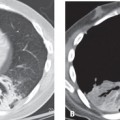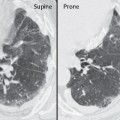CASE 126 37-year-old man with acute dyspnea HRCT (lung window) (Figs. 126.1A, 126.1B) demonstrates patchy bilateral diffuse ground glass opacity Farmer’s Lung; Hypersensitivity Pneumonitis • Pneumocystis jiroveci Pneumonia • Desquamative Interstitial Pneumonia (DIP) • Pulmonary Drug Toxicity • Alveolar Proteinosis Farmer’s lung is an occupational lung disease caused by exposure to moldy hay and inhalation of the associated antigen. Farmer’s lung was one of first recognized forms of hypersensitivity pneumonitis, a group of diseases characterized by an abnormal immunologic reaction to specific antigens in a variety of organic dusts. A long list of other forms of hypersensitivity pneumonitis now exists, including bird fancier’s lung, mushroom worker’s lung, and detergent worker’s lung. A striking similarity in the clinical, pathologic, and imaging features of these entities suggests a common pathogenesis (see Case 115). Hypersensitivity pneumonitis may develop acutely or may occur as a subacute or chronic disease, depending on the duration of exposure and individual patient susceptibilities. Fig. 126.1 (Images courtesy of Jud W. Gurney MD, University of Nebraska Hospital, Omaha, Nebraska.)
 Clinical Presentation
Clinical Presentation
 Radiologic Findings
Radiologic Findings
 Diagnosis
Diagnosis
 Differential Diagnosis
Differential Diagnosis
 Discussion
Discussion
Background

Etiology
Stay updated, free articles. Join our Telegram channel

Full access? Get Clinical Tree






